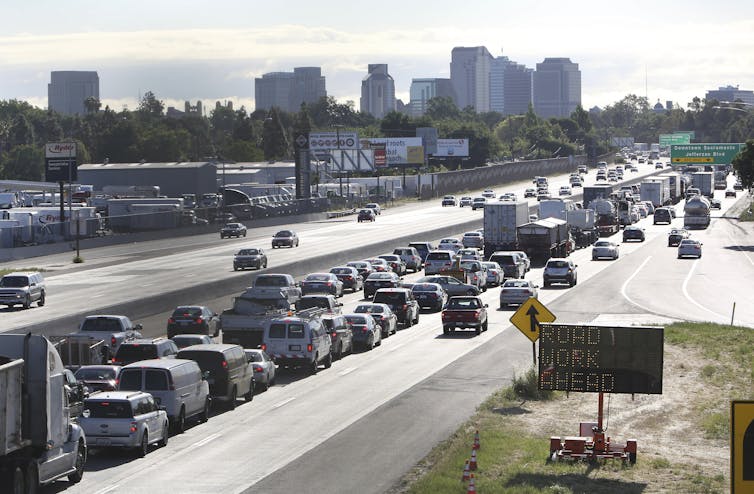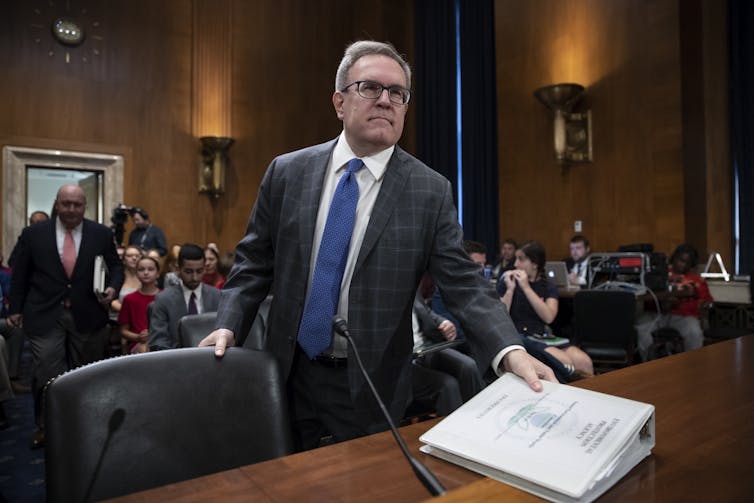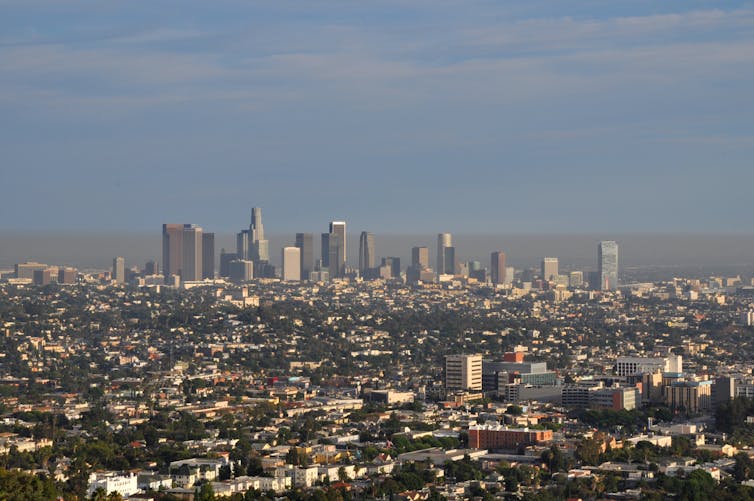Trump administration and California are on collision course over vehicle emissions rules
Meredith Hankins and Nicholas Bryner co-author legal explainer for The Conversation

AP Photo/Rich Pedroncelli
Meredith Hankins, University of California, Los Angeles and Nicholas Bryner, Louisiana State University
The Trump administration on Aug. 2 formally announced a proposal to freeze fuel economy standards and tailpipe emission standards for new cars. In addition, it is proposing to revoke California’s authority to set more stringent rules.
This move by the Environmental Protection Agency and the National Highway Traffic Safety Administration, while expected for months, is the most significant action yet in rolling back efforts by the Obama administration and California to cut greenhouse gas emissions that contribute to climate change. It also sets up an unprecedented legal battle between California and the federal government while breaking with decades of practice on regulating tailpipe pollution.
In fact, only hours after the announcement California Attorney General Xavier Becerra has indicated he intends to file a lawsuit in conjunction with 19 other state attorneys general to challenge the proposal.
Taking aim at California’s waiver
Under current regulations put in place by the EPA and NHTSA under Obama in 2012, auto manufacturers must make continuing improvements in fuel economy and tailpipe carbon emissions through 2025, up to an average of 54 miles per gallon and 163 grams of CO2 per mile. Built into the Obama-era regulations was a review process to assess manufacturers’ ability to meet those standards. The Obama administration conducted its own midterm review in January 2017, concluding the planned increases in fuel economy and more stringent tailpipe standards should remain in place.
In April 2018, the agencies under the Trump administration reversed their earlier position, finding the standards were not feasible. Now, the agencies have finished their review and seek public comment on a proposal to freeze both sets of standards at 2020 levels.

AP Photo/J. Scott Applewhite
But the EPA and NHTSA’s proposal doesn’t stop at the national standards. The agencies are also attacking California’s ability to set its own, more stringent standards. Because 13 other states and the District of Columbia have chosen to adopt California’s standards, 35 percent of the U.S. population would be impacted by any change.
What legal questions does this showdown between California and the federal government raise? In general, the Supremacy Clause of the United States Constitution provides that federal laws pre-empt, or supersede, conflicting state laws. Some federal laws also contain “express pre-emption clauses” that lay out the exact kinds of state laws Congress intends to pre-empt. The Clean Air Act’s express pre-emption clause generally bars states from setting their own laws relating to motor vehicle emissions.
But California has the unique authority to set its own motor vehicle emission standards due to the state’s notoriously poor air quality and its history of regulation predating congressional action on vehicle emissions. This authority dating back to 1967 is enshrined in a Clean Air Act provision, allowing California to seek a pre-emption “waiver” from the EPA. Other states can then opt in to California’s standards. California has received numerous waivers from the EPA over the years for each new iteration of the state’s vehicle regulations.
The EPA and NHTSA have proposed revoking California’s most recent waiver granted in 2013 for its Advanced Clean Cars program, an unprecedented attack against California’s historical authority. The EPA has only once denied California’s request for waiver, and even this was promptly reversed following a change in administration from Bush to Obama. In the 50 years since the Clean Air Act was enacted, the EPA has never revoked an existing waiver. And there is no textual authority in the Clean Air Act’s waiver provision for the EPA to do so.
Legal arguments
In particular, the Trump administration is seeking to eliminate California’s greenhouse gas tailpipe emission standards and the state’s Zero-Emission Vehicle (ZEV) program, which mandates an increasing percentage of vehicles sold in the state be zero-emission vehicles, such as electric vehicles. The EPA and NHTSA have proposed three possible legal arguments for revoking California’s waiver for these standards.
The first two arguments are based on the Clean Air Act’s criteria for denying a request for a new waiver, which have never before been used to justify revoking an existing waiver.
One of the three criteria that allow EPA to deny a request for waiver is if the state does not need the proposed regulations to meet “compelling and extraordinary conditions.” The Trump administration argues that the greenhouse gas tailpipe standards and the ZEV program are not needed to meet compelling and extraordinary circumstances particular to the state because climate change is a global problem.

Clinton Steeds, CC BY
But this ignores that the ZEV program was originally enacted in the 1990s for the purpose of reducing conventional pollutants like nitrogen dioxides (NOx) and other smog precursors as a necessary part of California’s statutory duty to meet health-based ambient air quality standards for ozone. Indeed, California’s unique smog and ozone problems are the primary reason the Clean Air Act allows California to seek a waiver in the first place. California continues to have the worst ozone problems in the country, and the ZEV program remains a key part of the state’s plan to meet the ozone standards.
Second, the EPA and NHTSA argue California’s greenhouse gas tailpipe standards and ZEV program are technologically infeasible, another basis on which the Clean Air Act allows the EPA to deny a request for waiver. Once again, we find that this argument ignores existing evidence to the contrary. The California Air Resources Board recently concluded that automakers were already over-complying with the state’s greenhouse gas tailpipe standards and exceeding the ZEV program’s annual requirements.
Finally, the EPA and NHTSA argue that California is pre-empted from regulating vehicle greenhouse gas emissions under a different federal law. The Energy Policy and Conservation Act, or EPCA, was enacted in 1975 and set up the framework for NHTSA to issue national fuel economy standards. EPCA expressly pre-empts any state laws “relating to” fuel economy. The EPA and NHTSA argue that California’s Clean Air Act pre-emption waiver to set vehicle emission standards does not extend to greenhouse gas tailpipe standards or the ZEV program because such standards are “related to” fuel economy, and thus pre-empted by EPCA.
As fellow UCLA law scholar Ann Carlson has explained in detail, this argument has already been explicitly rejected by two different federal courts, each of whom concluded that California’s greenhouse gas tailpipe standards are not pre-empted by EPCA because protecting public health by regulating greenhouse gas emissions is not the same thing as increasing energy efficiency by regulating fuel economy.
What comes next
While the announcement was made with great fanfare, it is still at this stage only a proposal. Under federal administrative law, the EPA and NHTSA first publish a proposal for how they intend to regulate. Once it is officially published in the Federal Register, every member of the public – the auto industry, the energy sector, states, environmental groups and everyday citizens – will have an opportunity to submit comments. Public hearings are also being scheduled in Washington D.C., Detroit and Los Angeles. Agencies must consider what the public has to say about the standards before they can be finalized.
Once the new regulations are finalized, the litigation will begin. States and environmental nonprofits are chomping at the bit to sue the Trump administration over its actions to freeze fuel economy and tailpipe emission standards. California has already warned it will challenge any determination that limits its long-standing authority to set more stringent standards.
Judicial review will focus on whether the relevant scientific and technical evidence support the EPA and NHTSA’s final decision. Judges often defer to agencies on these types of questions on the basis that agencies have the necessary technical expertise, but will force agencies to reconsider decisions when they are out of step with the weight of the evidence before them.
The coming litigation will most likely focus both on the evidentiary question of whether the EPA and NHTSA have adequately supported their determination that the Obama-era standards are infeasible, and the legal questions surrounding California’s authority to regulate vehicle emissions.
Meredith Hankins, Shapiro Fellow in Environmental Law and Policy, University of California, Los Angeles and Nicholas Bryner, Assistant Professor of Law, Louisiana State University
This article was originally published on The Conversation. Read the original article.
Reader Comments
6 Replies to “Trump administration and California are on collision course over vehicle emissions rules”
Comments are closed.







Dear Meredith,
I am sure you mean well and want to save people from grievous harm due to climate change, but California vehicle emission standards cannot do this. Like the CPP and Paris agreement, this too shall pass and it will soon be over-with and forgotten.
Why not be reasonable and simply use the same federal standards that are applicable everywhere in America? Young environment practitioners should stop living in the past and say goodbye to worthless environmental-nonsense that is typified by California vehicle emission standards.
“I am sure you mean well…”
ARE you sure that she means well? Isn’t she just a “climate mongrel”?
“Young environment practitioners should stop living in the past and say goodbye to worthless environmental-nonsense…”
You lack the self-awareness to understand that the rest of us who are actually well informed on the issue of climate see you as like a person going to an astronomers’ forum eagerly trying to convince them that the Earth is flat. You have no clue.
BQRQ,
Are you so beholden to your fanatical anti-Climate action, anti-Obama platform that you’re so easily willing to abandon other seemingly important positions like cooperative federalism, rule of law, and ensuring a stable business environment?
Let’s be clear – in conjunction with tariffs making all new vehicles more expensive the likelihood of this administration’s goals are even less likely to be realized. This does not make economic sense; we all know it does not make sense from a climate change perspective.
Sharon said;
“……it does not make sense from a climate change perspective….”
Dear Sharon,
California vehicle emission standards have no measurable effect on climate and do not mitigate climate change at all, not even a little bit. California’s standards do not realistically offer any actual reductions whatsoever in premature deaths, asthma, respiratory ailments, heart disease, and other such harms that may stem from air pollution.
From a climate change perspective it makes perfect sense to curtail and abandon worthless environmental regulations that purport to mitigate the climate, yet completely fail to do so. Why should we continue to waste huge public resources on California’s contrived, dishonest and deceptive vehicle emission standards which are predicated on that state’s discredited junk science and endorsed by its flakey California Environmental Bar ???
I recall going from Central or Northern California to LA every year to visit my grandmother in the Valley (Monrovia), and seeing my father’s sinus problems light off after passing what is now the Magic Mountain theme park and staying that way until we left. My eyes would itch most of the time. (Not allergies, we lived in Visalia much of my childhood and neither of us had a problem.)
She lived part way up the foothills a long walk uphill from Oak and you couldn’t see anything on the other side of the Valley through the haze. You often couldn’t see the mountain at Disneyland until you were on the freeway at the exit for the parking lot.
Later, whenever I flew into LAX I couldn’t see any of the mountains for the brown haze.
There has been tremendous improvement and at that time it wasn’t about carbon.
And it isn’t public money, it’s the car owner’s money, and they will get it back in fuel savings, especially when the standards are mandatory and hence there is a large enough market to make fuel efficiency features cost effective by mass production.